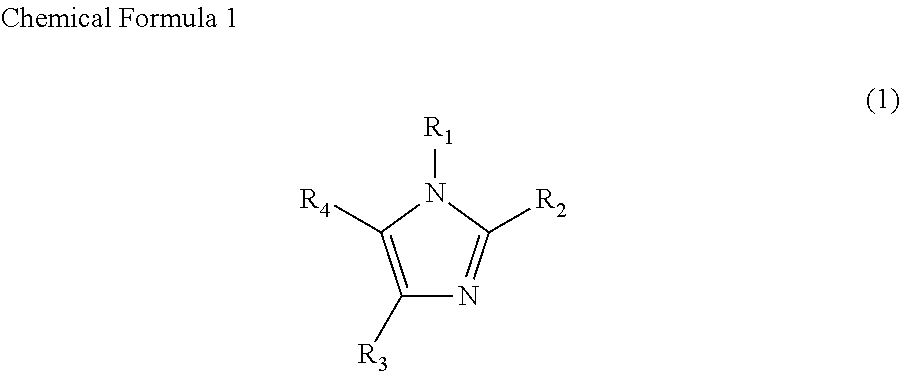Electroless plating pretreatment agent, electroless plating method using same, and electroless plated object
a technology of electroless plating and pretreatment agent, applied in the direction of liquid/solution decomposition chemical coating, solid/suspension decomposition chemical coating, coating, etc., can solve the problem of insufficient quantity of pd not being retained, palladium precipitation, and inability to obtain uniform solution, etc. problem, to achieve the effect of excellent adhesion, enhanced adhesion strength and excellent adhesion
- Summary
- Abstract
- Description
- Claims
- Application Information
AI Technical Summary
Benefits of technology
Problems solved by technology
Method used
Image
Examples
example 1
[0079]10.0 g (0.022 mole) of palladium neodecanoate and 5.3 g (0.055 mole) of 1,2-dimethylimidazole were added to 1 L of butanol, and dissolved by agitation and heating at 40° C. The resulting solution (electroless plating pretreatment agent) did not turn black even when heated for 1 week at 60° C., retaining the yellow color it had at preparation. After this heating, the electroless plating pretreatment agent was applied with a spin coater to a polyimide film, and when the Pd electron states of the resulting film were measured by XPS (measurement conditions: current value 30 mA, voltage 8 kV), 100% of the Pd(II) state was retained, or in other words all of the Pd was in the form of Pd(II). This polyimide was immersed for 10 minutes at 30° C. in a dimethylamine borane electroless plating activator (PM-R2, made by Nippon Mining & Metals Co., Ltd.), water washed, and immersed for 5 minutes at 30° C. in an electroless copper plating solution (NKM-554, made by Nikko Shoji Co., Ltd.) to ...
example 2
[0080]Electroless copper plating was performed by the same operations as in Example 1 except that the pretreatment agent was applied by spin coating to a glass epoxy substrate in place of a polyimide film. Furthermore, copper electroplating was performed for 50 minutes at 2.5 A / dm2 using a copper electroplating solution (copper sulfate 72 g / L, sulfuric acid 180 g / L, chlorine 60 ppm, brightening agent 1 mL / L) with a phosphorus-containing anode, forming a 25 μm-thick copper plated film. The adhesion strength of the plated film was measured by the 90-degree peel strength test. The peel strength test showed a strong adhesion strength of 1.2 kgf / cm2.
example 3
[0081]Electroless copper plating was performed by the same operations as in Example 1 except that 8.6 g (0.022 mole) of palladium octylate was added in place of 10.0 g of palladium neodecanoate, and the adhesiveness of the resulting electroless plated film was evaluated. As in Example 1, it was confirmed that the electroless plating pretreatment agent did not turn black even after being heated for 1 week at 60° C., and 100% of the Pd(II) state was retained. Moreover, the resulting electroless plated film was formed uniformly on the entire surface of the polyimide film, and the adhesion strength of the plated film was confirmed to be good in the tape test.
PUM
| Property | Measurement | Unit |
|---|---|---|
| concentration | aaaaa | aaaaa |
| concentration | aaaaa | aaaaa |
| width | aaaaa | aaaaa |
Abstract
Description
Claims
Application Information
 Login to View More
Login to View More - R&D
- Intellectual Property
- Life Sciences
- Materials
- Tech Scout
- Unparalleled Data Quality
- Higher Quality Content
- 60% Fewer Hallucinations
Browse by: Latest US Patents, China's latest patents, Technical Efficacy Thesaurus, Application Domain, Technology Topic, Popular Technical Reports.
© 2025 PatSnap. All rights reserved.Legal|Privacy policy|Modern Slavery Act Transparency Statement|Sitemap|About US| Contact US: help@patsnap.com



